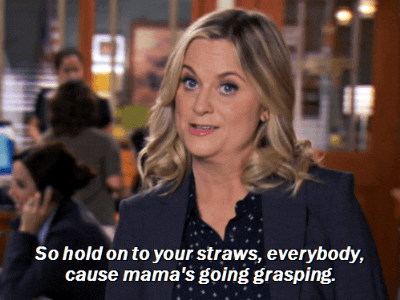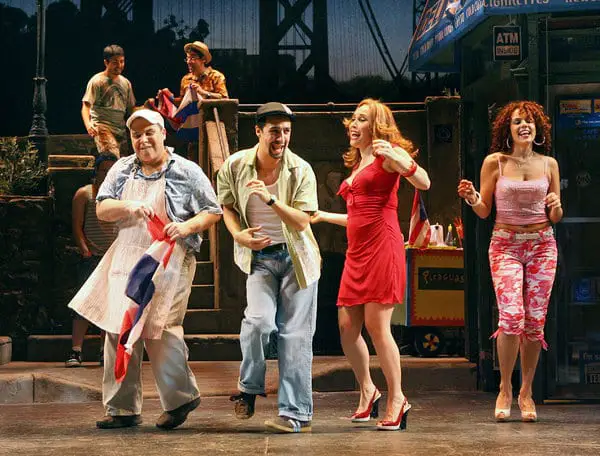Two solo songs, a spotlight in several other, his own plotline, and still we don’t know his name. Who even is the piragua vendor from In the Heights? In such a tight time frame as a two hour long musical, of course, characterization and themes have to be condensed and characters don’t all get the same development as the leads. Side stories are often meant as foils for the main plot and offer thematic relevance. The piragua guy offers both, and yet no name, no information about him aside from the few scenes he is in. I have talked before in few details of this mystery man, but doesn’t he deserve a post of his own? Let’s don our tinfoil hats and over analyze those scenes to reach too specific and probably far too reaching conclusions, shall we?

(I apologize in advance for this very self-indulging post about a minor nameless character. This isn’t meant to be set in stone or even realistically reflecting the original idea of the character. I don’t know for sure what Lin-Manuel Miranda meant with him. I just have many thoughts about this guy.)
The piragua vendor, a role originated by the ever talented Eliseo Román, makes his appearance very early in the story as he greets Usnavi at the beginning of the opening song.
“Oye, piragüero, como estas?”
“Como siempre, Señor Usnavi.”
How unsurprising that these two would be friends: the piragua vendor serves as the perfect backdrop to Usnavi’s initial desire to go back to the Dominican Republic. This is best illustrated by the part of Carnaval del Barrio where they sing together in Spanish about wanting to go “home”, respectively to Puerto Rico and the Dominican Republic.

This makes the piragua guy a foil of our protagonist, in that he mirrors and also personally encourages Usnavi’s dream to leave America and go back to his island. If he’s going to symbolize the Latino pride in Usnavi’s plotline, he does it marvelously through all their interactions. They only ever speak Spanish together and bond over their love for their island. This isn’t to mention their similar personal experiences as business owners in a struggling neighborhood riddled by gentrification, but let’s not get ahead of ourselves here.
If he can be as Latino as he can in Usnavi’s plotline, the way the piragua guy is used in Nina’s storyline is slightly different. Here, in the song Breathe, his singing, along with the rest of the ensemble, reminds Nina of her home in New York and how heavy the weight of their expectations on her shoulders. Though he is still the same proud Latino man as he is in his scenes with Usnavi, in Nina’s story, he symbolizes the most definitely American neighborhood in the heart of Manhattan. He symbolizes the life the Latinx immigrants have made in America and the hopes of a better future they rest in the person of Nina. In his singing, she recognizes the love her people hold for her right here in New York.
In this way, the duality that is the core of In the Heights, how Latinx and how American you can be at the same time, and how do you weigh out these identities, is present in him even from his small appearances in both these stories. Either aspect of him manifests itself more when he is interacting with the protagonist who is leaning more towards one side of this identity struggle. The Latino side of him comes out most strongly in the presence of Usnavi, who is incredibly proud of his roots. However, Nina is initially much more estranged from the island her parents came from and is instead rather focused on the place she grew up in (don’t mind me here crying over how Nina and Usnavi’s stories parallel each other so well, him finding love for New York after a life of longing for his island, a love that Nina had all along but she instead learns to appreciate her background and the experiences of her immigrant elders), and indeed, the piragua guy and his singing grounds her in the reality of Washington Heights.
This isn’t even to mention the elements highlighted by Usnavi as specific to the Latinx experience of Washington Heights that also just so happen to be the core of piragua guy’s life specifically.
“You’ll see the late nights, you’ll taste beans and rice, the syrups and shaved ice.”
“In the Heights, I hang my flag up on display.”
(Yup nothing to see here, it’s not like the piragua guy has a cart with flags of all countries mentioned in the musical, his Puerto Rican flag the biggest, where he sells syrups and shaved ice)
This tidbit aside, let’s dive into the piragua guy’s actual narrative. First of all, I’m highlighting this again: for a minor nameless character, he has a whole narrative of his own with a set-up, a conflict, and a resolution. That’s more than can be said about most other characters of the musical, who mostly serve Nina or Usnavi’s stories, with Benny and Vanessa both having side struggles of their own that mirror their respective love interest’s narrative. The piragua guy’s story is his own only. Our dude is a pretty big deal.
Again, where the piragua vendor was the voice of Latinx pride in Usnavi’s story, of the love of the neighborhood in Nina’s story, he keeps being the mirror of his community when you compare his story to the other business owners of the musical. Poverty is a major theme in this story, as it is indeed the plight of many immigrants, here specifically Latinx immigrants who have to fight gentrification in the neighborhood they’ve made their own. Of course, there is Usnavi’s story: even from the beginning, we know that he is debt-riddled and that if he ever won the lotto, half of it would need to go to paying back those debts before he could even treat himself. The thematic is also present in Nina’s storyline. Her father is the owner of a taxi business and he is struggling financially to keep his family afloat, having laid down half of his drivers in the past year. He is constantly harassed with offers to sell his company and eventually accepts, using the money to pay for his daughter’s college tuition. Then, the theme of businesses going afloat is also present in the character of Daniela. Gentrification has made the rent unsustainable for her salon and she has to move to the Bronx to maintain her position as a business owner and be able to keep her two employees.
The piragua vendor offers a similar narrative at a somewhat smaller scale. He sells piraguas in the street. With the cultural evolution and standardization of goods, people just aren’t interested in piraguas as they used to, rather eating generic ice cream from Mr Softee. The blackout strikes and Mr Softee’s truck breaks down: suddenly everyone rushes to his piraguas again and he can keep his head above water for a while. It’s a very simple story told in two short songs, with more than a small dose of humor. Piragua Reprise (which, by the way, fun fact, was written just three days before the opening of Broadway previews of In the Heights) may be the only Broadway reprise song that is happier than the original. His story is very endearing and the songs are so damn catchy. I’m singing them right now. Piragua, piragua…
Overall, the piragua guy is simply the face of the community, a voice that sings just a bit louder than the rest. It’s no mistake that he is the only “major” character (as in, actually afforded a description in the cast list) who is also otherwise part of the ensemble. I believe he is meant to be the bridge between the ensemble, the nameless community, and the personal struggles of major characters, finding his spot right in the middle. Rather than risking the impression that the struggles the main characters are going through are personal and individual (which they are, but not only), we’re given another smaller narrative that portrays them again, with the piragüero’s personal twist as a good-natured, cheerful man. Rather than talking about how hard it is to keep your business afloat and how immigrants love their home country as much as the new one, Lin-Manuel Miranda gave us an additional face to put on these struggles. Of course the piragua guy shares elements of all the other stories. He’s meant to be representative of a fully-fledged experience shared by so many. His story is simple and yet quirky enough that no one can help feeling deep sympathy for him.
So this was the interpretation of the piragua guy’s story kept strictly to the musical itself. Is there more to him? I believe so, I think there is additional substance to the character to be found. I think the piragua guy is another projection of Lin-Manuel Miranda in the story.
“There’s sort of two ways of dealing with being an outsider, being a minority culture […]. You either blend in or you grab that flag and you wave it as hard as you can and I think I was very much of the grab the flag school.” − Lin-Manuel Miranda
Note that I am not saying this in any disparaging way whatsoever. I think projection, or rather representation, here meaning creating and shaping characters to reflect your exact personal characteristics and struggles, is very good. It’s not anything new from him, anyway. In both his musicals, we see a protagonist to which he assigns many of his personal traits. The Hamilton he plays (which is similar but not identical to historical Hamilton) and Nina Rosario are both very driven people, eager to achieve more than their peers and in less time, too. Hamilton writes and writes, Nina works her way ahead of her community. Even Usnavi, although Lin has claimed before that he wrote Nina as self-projection rather than Usnavi, has many traits in common with him, in his love for his island (not the same one, but Usnavi being Dominican makes sense in other ways), equally matched by his love for his American experience.
And the piragua guy in all this? Well, couldn’t he be another kind of self-insert coming from a Puerto Rican playwright? He walks around all day with a cart on which he painted a Puerto Rican flag! In fact, half of the characters of the play are Puerto Rican despite the fact that Washington Heights is, in real life, mostly populated by Dominican Americans, against just two (three if you count Carla’s Chili-Domini-Cu-Rican multi-backgrounds) of them in In the Heights. In the musical, he obviously wanted to give a larger space to specifically his Puerto Rican culture, starting with a Puerto Rican treat sold by our dear piragua guy. I think that the character was meant as another kind of flag-waving from the author. Not only does he symbolize and represent broader themes of Latinx American experience in general but he is also a showcase for a specific culture, a way to show some love to one island in particular. There were rumors that Lin-Manuel Miranda would cameo as the piragua guy in the upcoming In the Heights movie…
The conclusion in all this? Is there even one? I’m probably reading way into this minor character. But at least, this means there is an opening, some room within the narrative to overanalyze him. I don’t think the writing of In the Heights was accidental. I don’t think that not giving him a name was accidental either. So if you’ll allow me, I’m going to keep on obsessing over my nameless favorite street vendor.

